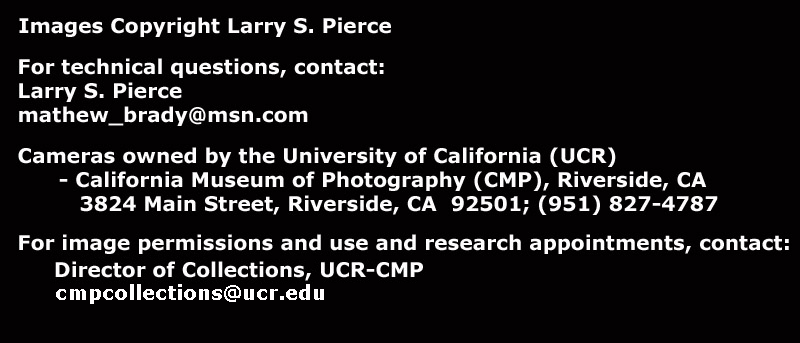Scovill Mfg. Co.
American Optical Company
Front Focus Cone
View
Camera Variation 3.0
Front Focus Reversible Back View Camera
Variation 3.0
St. Louis
View
Camera Variation 3.0
8x10
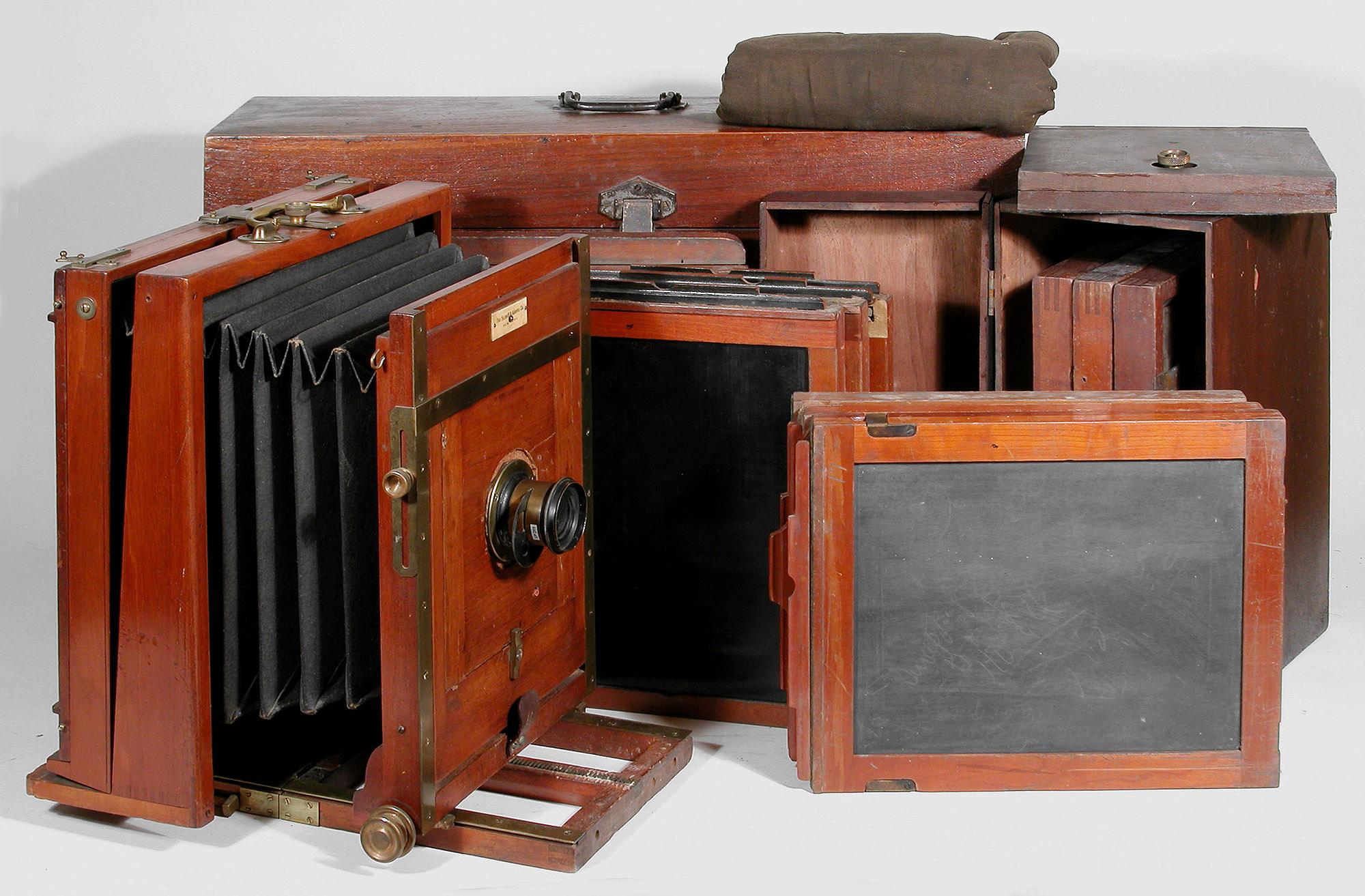
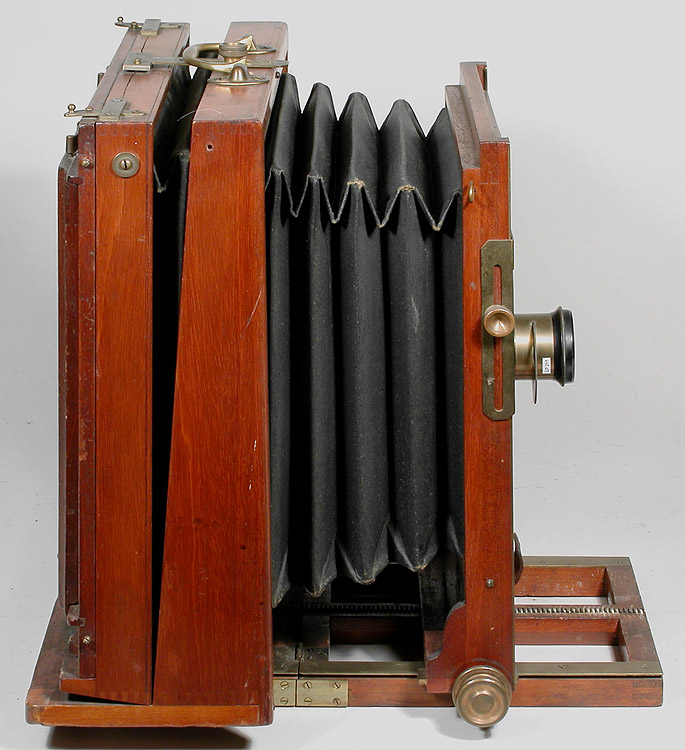
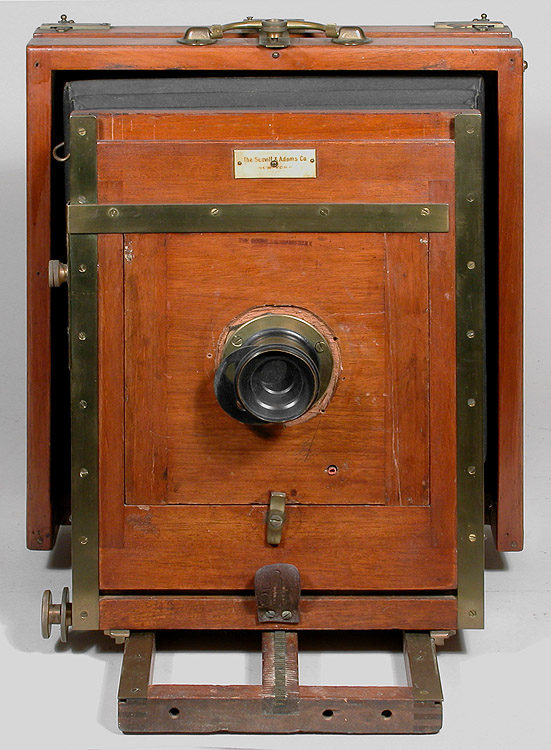
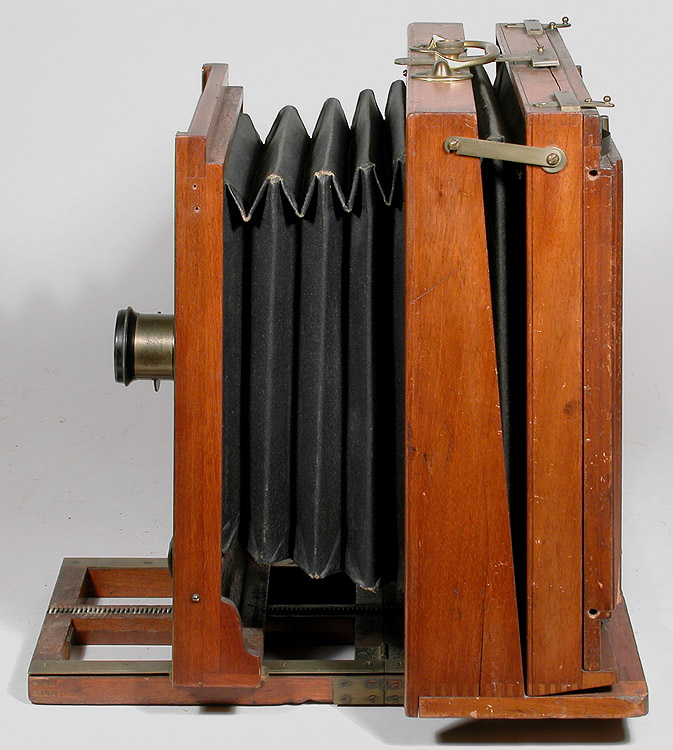
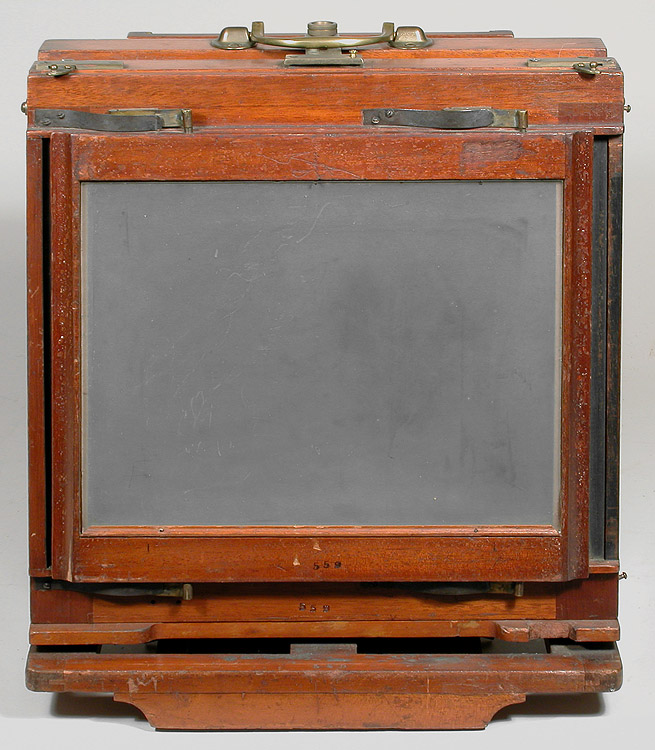
Manufacturer:
American Optical Co. New York, NY factory
Date Introduced: - ; Years Manufactured:
c.1889
Construction: front focus
via rack and pinion (single gear track on top of middle base rail);
0/1/2 swings; reversing by removable back; three-piece lens board
Materials: mahogany body; cherry base;
black fabric bellows; brass hardware
Sizes Offered: 4x5; 4 ½x5 ½; 5x7;
6 ½x8 ½; 8x10
Notes:
St. Louis View Camera:
The St. Louis model is
identical to the
American Optical Flammang's Revolving Back Front Focus Camera, except
that it has a removable and
reversing back rather than a patent revolving back.
When advertised,
engravings for this camera usually
carry a "Scovill" identification
rather than an "American Optical"
identification. Yet many cameras exist, such as the
St. Louis Variation 1 8x10
example,
that are stamped American Optical or have a silver
label marked American Optical. Such AO-marked cameras have
the usual high quality construction and finish
associated with the AO factory. Other examples are
unlabeled, or have a Scovill & Adams Co. label (see
St. Louis Variation 3).
It is possible that St. Lous cameras were made in both the American Optical factory in
New York City (where the high quality and craftsmanship cameras were
made) and the Scovill factory in New Haven, CT (where the less quality
craftsmanship cameras were made).
At least
six variations of the St. Louis exist, based
mainly on the location of the swing (bottom or center of the rear standard) and
style of spring back. The odd thing is that both styles of swing
are found with both styles of backs. It is probable that the
flatter style of back was an improvement (i.e., later) version of the
clunky style of back. But is the bottom swing an improvement over
the center swing? Or vice versa?. In any case, the
distinguishing features of the four variations are: Variation 1.0:
Thick clunky back; single swing is hinged at the bottom of the rear
standard. From the discussion under
Variation 3, it would appear that
this thick clunky-type back was made c.1885-c.1889. It appears that all engravings show the bottom swing
pivot. Variation 2.0:
Thick clunky back; single swing is hinged at the center of the rear
standard. From the discussion under
Variation 3, it would appear that
this thick clunky-type back was made c.1885-c.1889. Variation
2.1:
Thick clunky back; single swing is hinged at the center of the rear
standard. Identical to
Variation 2, except that the wood
throughout is some soft wood, possibly poplar, rather than mahogany.
The example that represents this variation is the only St. Louis camera
ever seen that was not mahogany. That it was made from a
non-hardwood is extremely unusual. Poplar was used only in the
least expensive of Scovill's line, e.g., the
Ne Plus Ultra.
Variation 3.0:
Thin four-spring back; single swing is hinged at the bottom of the rear
standard. From the discussion under
Variation 3, it would appear that
this thin four spring-type back was made c.1889-c.1891. The American Optical/Scovill & Adams
Co. Four Spring Back
Variation 4.0:
Two-spring back, nearly identical to backs made by the Blair Camera Co.
in the 1880's;
a single swing is hinged at the center of the rear standard. The
back on this variation appears to be a design patented by the Blair Camera
Co. in 1884 (US 304,406), in
that it has the following features: two large, one-sided springs screwed
on one end and resting on wooden dowels at the other end, a ground glass
installed in a slot, two wooden corners, each with a hole, at one end of
the ground glass frame, four horizontal plates as hinges for the ground
glass frame, and a metal pull tab to assist in pulling the ground glass
frame upwards. Despite appearing to be
the Blair design, the back matches the wood grain, color and finish of the
remainder of the camera perfectly,
as if the entire camera was manufactured and finished at one time. Also,
the back is unmarked, whereas Blair
camera backs were generally stamped on their interiors with the name of
the company. A similar Blair design back is found on
Variation
4.1: Same as
Variation 4,0, except that it has brass plates
reinforcing both sides of the lower rear standard. The brass has
been draw-file finished and lacquered, like the rest of the hardware,
and appears to be similarly aged as the rest of the hardware.
There is no damage to the wood under the plates. It would seem
that they were installed at the factory to prevent damage in this
critical spot. References:
Back to American Optical
Co. / Scovill Mfg. Co. (alphabetical)
This back consists of a ground
glass frame connected to the back of the rear standard using four
springs, one in each corner, and each about 2-3 inches long. As
One end of each spring is tightly screwed to the rear standard, while
the other end applies pressure onto the middle of a hinge made of sheet
brass about 2 inches long, which is attached, one end to the ground
glass and the other to the rear standard, via round-head wood screws
long enough to act as axles. Three of the corners appear as in the
left hand photo below. The fourth corner contains the spring, but
also an extra bit of hardware attached to the sheet brass that catches
in an open position on a post. This is shown in the right hand
photo below.
This type back found on a number of cameras in this
collection, including: A similar back is found on the 1)
Scovill & Adams labeled
Acme Reversible Back View Camera Variation 3, 2)
unlabeled
Albion Variation 3, 3)
American Optical, Scovill & Adams Co., Prop'rs
labeled Compact View Variation 2 or Irving View Variation 2,
4) American Optical,
Scovill & Adams Co., Prop'rs labeled Irving View Variation 1.(known
to have been introduced in March, 1892), 5)
Scovill & Adams labeled
St. Louis View Camera Variation 3, and 6)
Star View Camera
(introduced 1890) - one example labeled
The Scovill & Adams Co., the other example labeled
American Optical Co., Scovill & Adams Co.,
Prop'rs).
From the example cameras from six models that have four
spring backs, we find that all but one camera (and that one is unlabeled
and so indeterminate) are labeled and thus can be dated from when
The Scovill & Adams Co. were
proprietors of the
American Optical Co.,
that is, 1889-c.1899. It would therefore appear that the four
spring back was introduced approximately when
Scovill Mfg. Co. changed to
The Scovill & Adams Co. in
1889. The four spring design was patented in
1889 (granted to Scovill Mfg. Co. (W.H. Fuller, assignor), #407587, 23
Jul 1889), but, unlike most of their patents, the patent information is
not stamped into the wood or otherwise appear on cameras using the
patent.
That the St. Louis
Variation 3 has this four spring back, it represents a
chronologically later version than
Variation 1 and Variation 2,
which have the clunky spring back.
Catalog P, Photographic Material,
J. W.
Queen & Co. (Philadelphia, PA), 1886, p.
73 (As
Reversible Back Cone View Camera, but no engraving to check
construction)
Not in the
Scovill & Adams March 1890 catalog
American Annual of Photography and Photographic Times Almanac for
1897, The Scovill & Adams Co. (New York, NY),
1896, ads p. 61 ("Bargain
Page" only, i.e.,
leftovers - no engraving, but probably has the low profile back at this
late date)
American Annual of Photography and Photographic Times
Almanac for 1898,
The Scovill & Adams Co. (New York, NY), 1897, ads
p. 115 ("Bargain Page" only, i.e.,
leftovers - no engraving)
